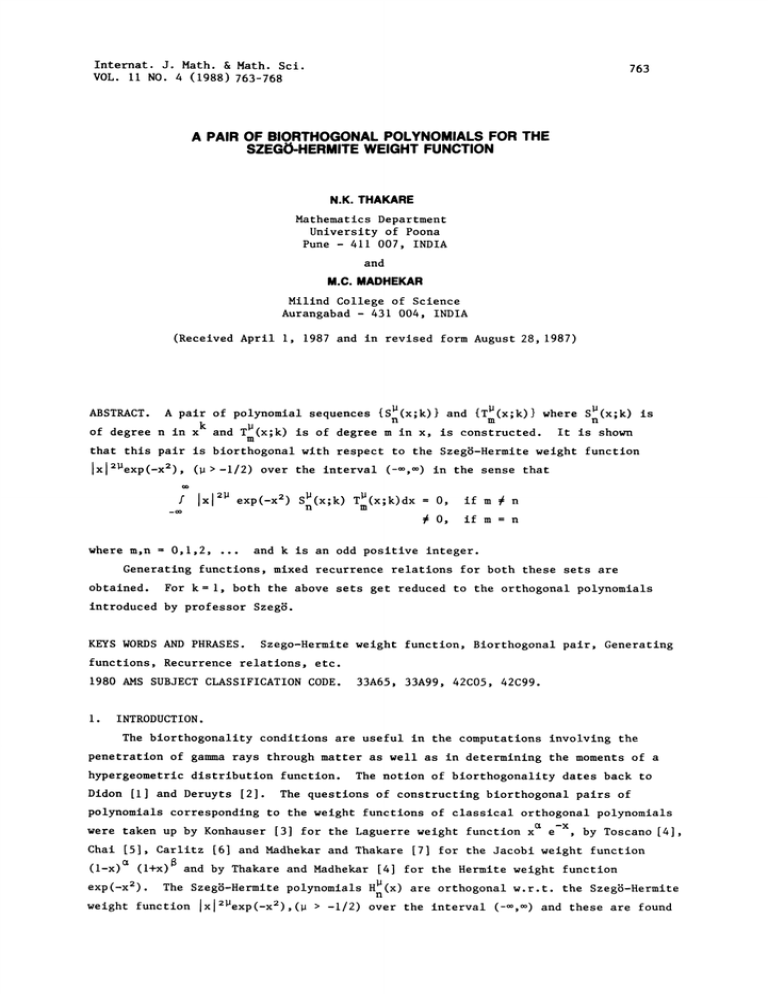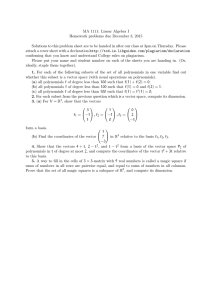SZEGO-HERMITE PAIR BIORTHOGONAL THE
advertisement

Internat. J. Math. & Math. Sci.
VOL. Ii NO. 4 (1988) 763-768
763
A PAIR OF BIORTHOGONAL POLYNOMIALS FOR THE
SZEGO-HERMITE WEIGHT FUNCTION
N.K. THAKARE
Mathematics Department
University of Poona
Pune
411 007, INDIA
and
M.C. MADHEKAR
Millnd College of Science
431 004, INDIA
Aurangabad
(Received April I, 1987 and in revised form August 28, 1987)
ABSTRACT.
A pair of polynomial sequences {S(x’k)} and {T(x;k)} where S(x;k) is
n
m
n
k
and T(x;k) is of degree m in x, is constructed. It is shown
m
of degree n in x
that this pair is biorthogonal with respect to the Szeg-Hermite weight function
Ixl2exp(-x2),
f
( >-I/2) over the interval (--,-) in the sense that
Ixl 2
exp(-x 2)
S(x;k) T(x;k)dx
0
0,
where m,n
0,1,2
if m
#
n
tfm--n
and k is an odd positive integer.
Generating functions, mixed recurrence relations for both these sets are
obtained.
I, both the above sets get reduced to the orthogonal polynomials
For k
introduced by professor Szeg.
KEYS WORDS AND PHRASES.
Szego-Hermite weight function, Biorthogonal pair, Generating
functions, Recurrence relations, etc.
1980 AMS SUBJECT CLASSIFICATION CODE.
I.
33A65, 33A99, 42C05, 42C99.
INTRODUCTION.
The biorthogonality conditions are useful in the computations involving the
penetration of gamma rays through matter as well as in determining the moments of a
hypergeometric distribution function.
Didon
[I] and Deruyts [2].
The notion of biorthogonality dates back to
The questions of constructing biorthogonal pairs of
polynomials corresponding to the weight functions of classical orthogonal polynomials
were taken up by Konhauser [3] for the Laguerre weight function x
e
--X
by Toscano [4],
Chai [5], Carlitz [6] and Madhekar and Thakare [7] for the Jacobi weight function
(l-x)
(l+x) 8 and by Thakare and Madhekar [4] for the Hermite weight function
exp(-x2).
The SzegS-Hermite polynomials
weight function
Ixl2exp(-x2),(
>
H(x)
n
are orthogonal
w.r.t,
the Szeg-Hermite
-1/2) over the interval (-,) and these are found
N.K. THAKARE AND M.C. MADHEKAR
764
useful in connection with Gauss-Jacobi mechanical quadrature, see Szeg8 [8].
For
O, Szeg-Hermite polynomials are just the classical Hermite polynomials.
2.
A BIORTHOGONAL SYSTEM.
We shall construct a pair of biorthogonal polynomials
weight function
Ixl2exp(-x2),
>
-1/2.
the Szego-Hermite
w.r.t,
Consider the following pair of polynomial
sequences.
S(x;k)
n
2nF((kn +
TV(x;
k)
n
k- ke)/2 +
]j xnk-2kj/F
(-l)J
[n/2]
(_i)[n/212n
[n2]
((kn+l+e)/2-kj+)"
xn_2r/([n/2]_r)!
(_l)S
r=O
((2s+(k+l)e +
where the value of
+ e)
is 0 or
s= 0
2v+l)/2k)[n/2 ],
(2.1)
[n/2]-r
s
(2.2)
according to even or odd nature of n.
Throughout this
paper e always has this meaning; and [p] is the greatest integer less than or equal
to p.
It is fairly easy to verify after reverting the order of summation for even and odd
integers that
Sn(X;k
(-l)n22n
(-I)
n
T2n
n
22n+l
(-l)n22n
(-l)n22n
n
E
n!
(-l)n22n+l
Za(x;k)n
and
Yna(X;k)
k
22r
--r!
(x2;k);
x
r
2kj+k
(2.4)
rs
(_l)S
Z
s=0
((s++I/2)/k)n’
YV-I/2(x2;k),
n
n
l
n! x
(2.5)
r
(x2r+I/r’).
I
xcaexp(-x)
r(kn + ca + I)
n’
(_l)S
s=O
yV+k/2
n
(2.3)
r (kj++l+k/2)
zV+k/2
(x2;k);
n
rs
((s+v+l+k/2)/k)n’
2
(2.6)
(x ;k).
is a pair of Konhauser
the Laguerre weight function
Zca(x’k)
n
x
r=0
(-l)n22n+l
Here
n
j
(-I) j
E
r(kn++l+k/2)
j=O
r=0
Iv (x;k)
T2n+
x2kj /r(kj++I/2)
J
n! [F(kn+v+k/2)/F(kn++I/2)] Z v-I/2
n
(_l)n22n+In!
(x;k)
n
(-I) j
Z
j=0
(_l)n22n
S2n+l (x’k)
n
r(kn++k/2)
[3] biorthogonal polynomials w.r.t.
over (0, ,) and are given by
n
Z
j--O
(-I) j
n
j
x
r(kj +
kj
+ I)
(2 7)
BIORTHOGONAL POLYNOMIALS FOR THE
x
r=O
r
r
7.
(-i)
r
s
s
s=O
765
WEIGHT FUNCTION
((s++l)/kn)"
see Carlitz [9]
(2.8)
6(n,m)
(2 9)
-I, and k is a postive integer, and
>
where
.
n
l
Ye(x;k)
n
SZEG6-HERMITE
I
x
a
e
-x
Z (x;k)
n
0
F(kn+e+l) 6(n,m)
n!
dx
with
Using [I0] one readily obtains the following biorthogonality
the Kronecker’s delta.
condition for the sets {S
2
yam (x;k)
(x;k)}
n
and {T (x;k)}:
m
2) S(x;k)
TU(xk)
m
n
I
Ixl 2u
2n
[n/2]! r(+e+(kn+k-ke)/2)
exp (-x
dx
(2.10)
6(n,m)
An independent proof of (2.10) is also possible by using the identity of Carlitz [9,
p. 249]
m
(-J) m
m-r
kj+c+m-rm_r
7.
r=O
(-1
7.
s
s=O
m-rs
(s+c+ )/k) m"
and T(x;k) must be an odd
S(x;k)
m
n
positive integer in view of the existence theorem for blorthogonallty due to
One has to note, however, that k is involved in
Konhauser [I0, p.255].
One readily obtains
r(kn+k++I/2) S 2n+l (x;k)
T
Zn+l
(x;k)
2x
D S B (x’k)
2n
3.
2x
_+(k+l)/2
-I-2n
4 nk
xk-I
k
F(kn++l+k/2)
+(k+l)/2 (x;k)
S2n
and
(2 II)
(2.12)
(x;k)
B+(k-l)/2 (x;k)
2n-
F(kn+B+k/2)
F (kn+B+ / 2)
(2.13)
SOME PROPERTIES.
Using the relationship (2.3) to (2.6) it is fairly easy to obtain many results
for the Szeg-Hermite biorthogonal pair of polynomials from the known results for the
The results stated below could also be proved directly.
Konhauser biorthogonal sets.
Recall the Calvez and Ge’nin [II] generating function in the form (see also
Srivastava
12
Z
n=0
m+nn
where m is any integer
Ym+n
n
(x;k) t
0 and R
R
(l++mk)exp{x(l-R) Y(xR;k)
(l-t) -I/k.
(3.1)
By handling even and odd cases
separately, from (2.5) and (2.6) respectively, one obtains
l
n=O
T2m+nV (x;k)tn/[n/2],.
VU(+mk+(l+k)/2) [u-k T m(XU;k)
V
exp{x2[l-(l+4t2)-I/k]}.
(3.2)
+
t
V
T2m+l (xU;k)]
where
U=(l+4t2) -I/2k
The special case with m=O is worth noting.
and
Using (3.2)
for even case and then applying (2.12) one obtains in a combined form the recurrence
relation for the second set
N.K. THAKARE AND hi. C. btADHEKAR
766
[n12]
:
T(x-k)
nl2m (U-l) Tn-2m(x;k)’ l#
(-1 )m 2 2m
and ,>-I12.(3.3)
m
m0
O, and n even in (3.3) and using the blorthogonality condition (2.10) we
Taking
have the integral
I {x{ 21 exp (-x 2)
(_i)
n
4
m+n
Sl2m (x;k) T2n(X;k)
(-n)m(-I/k)n_mF(km+l+k/2)
(3.4)
dx
0,
where with
T2n(X;k)
is the
second biorthogonal set suggested by the Hermite polynomials; see Thakare and
Madhekar [4].
The integral (3.4) says that
T2n(X;k)
are othogonal to
Ixl21S 12m(x;k)
the weight function exp(-x 2) when n > m+I/k.
w.r.t,
Consider the generating function first given by Genin and Calvez
[13]; (see also
Karande and Thakare [14], Prabhakar [15]):
where
Z
n=O
(c)nZ
Itl
<
(x;k)
(l-t)
-c
F
txk/(l-t)kk
k
(3.5)
(k, l+a)
and A(m,6) stands for the sequence of parameters 6/m, (6+l)/m
(6+m-l)/m, (m>l).
Sn(X;k)_
even
tn/(l+a)kn
Using (2.3) one obtains from (3.5), an expression involving
which after putting to use relation (2.11) gives a corresponding
relation for odd
S2n+l (x;k)
This resulting expression further with the help of the
relation
Z
n=0
(C)n s2n+
(x;k) t2n+I/n! (+k/2) nk
t(k+2+ke)/(k+2B)
Z
n=0
(3 6)
(C)nSn+l(X;k)= t2t/n!(+l+k/2)nk
where 8=t, d/dr
yields
(c) n
n!
n=O
IFk
where W
(+k/2)nk
(k,u+l+k/2);
S
2n+l
(x;k)t 2n+l
2tx
k
ckt3x3ku 2k(c+2)
+ 16
(k+2) (l++k/2)
k
8ckt 2
u-2k(l+c) (u-2k -)
k+2
+I;
IFk
(3.7)
W
A(k,l++3kl2;
4x2kt2/(l+4t2)kk
In fact, one obtains after combining even case with (3.7) the following generating
function for the first blorthogonal set
Z
n=0
In/2]!
(C)[n/2]
(+k/2)k[n/2]
S (x;k) t
n
{S(x;k)}:
n
n
(+k/2)
(+I/2)
k+2u
3
3k
2k(c+2)
U
ckt x
+ 16
(k+3) (l++k/2) k
V
c;
u2kc IFk
(k,+i/2);
(k, 1++k12);
V
c+l;
iFk
A(k,l++3k/2;
W
W7
BIORTHOGONAL POLYNOMIALS FOR THE
SZEG-HERMITE
WEIGHT FUNCTION
We finally state the differential equation satisfied by the first set
767
{S(x;k)}
in the form
[x2(xD+2v+l+e)]k {xl-2k
(2x2) k
S(x;k)
n
{x D
nk
(D-ek/x)
Sn(X;k)}
S(x;k)}
n
anda differential recurrence relation
(3.9)
for the second set
k T
n+2
ACKNOWLEDGEMENTS.
(x;k)
-2xD
T(x;k)
n
2(l+ml+2-2x
2) T(x;k)
n
(3.10)
The authors are grateful to the referee for fruitful suggestions.
REFERENCES
I.
DIDON, M.F. Sur certains systems des polyn6mes associes, Annal Sci de l’Ecole
Normale Sup 6 (1869), 111-125.
2.
DERUYTS, J. Sur Une class de polynmes conjuges’, Mem. Cor. et Mem. de Savant
Enstr., Acad. Royal des Sci. des letters et des Beaux, Art de Belgique 48 (1886).
3.
.
KONHAUSER, J.D.E. Biorthogonal polynomials suggested by the Laguerre polynomials,
Pacific J. Math. 21 (1967), 303-314.
5.
CHAI, W.A. Problem 72
17, "Biorthogonal conditions for a class of polynomials,
SlAM Rev. 14 (1972), 494.
6.
CARLITZ, L. Problem 72 -17, "Biorthogonal conditions for a class of polynomials,
SlAM Rev. 15 (1973), 670-672.
MADHEKAR, H.C. and THAKARE, N.K. Biorthogonal polynomials suggested by Jacobi
polynomials, Pacific J. Math. I00 (1982), 417-424.
7.
THAKARE, N.K. and MADHEKAR, H.C. Biorthogonal polynomials suggested by the
Hermite polynomials, Indian J. Pure AppI. Math. 17 (1986), 1031-1041.
Orthogonal Polynomials, Amer. Math. Soc. Colloq. 23 (1974.
8.
SZEGO, G.
9.
CARLITZ, L. A Note on certain biorthogonal polynomials, Pacific J. Math. 24
(1968), 425-430.
I0.
KONHAUSER, J.D.E. Some properties of biorthogonal polynomials, J. Math. Anal.
Appl. II (1965), 242-260.
Ii.
CALVEZ, L.C. and GENIN, R.
12.
SRIVASTAVA, H.M.
Appl. des relations entre les fonctions genratrics
et les form de type Rodrigues, C.R. Acad. Sci. Paris A-B 270 (1970), A41-A44.
Some biorthogonal polynomials suggested by the Laguerre poly-
nomials, Pacific J. Math. 98 (1982), 235-250.
Sur les fonctions fe’ne’ratrices de certains polynomes biorthogonaux, C.R. Acad. Sci. Paris A-B 268 (1969), AI564-AI567.
13.
GENIN, R. and CALVEZ, L.C.
14.
KARANDE, B.K. and THAKARE, N.K.
Some results for Konhauser biorthogonal polynomials and dual series equations, Indian J. Pure Appl. Math. 7 (1976),
635-646.
15.
16.
PRABHAKAR, T.R. On the other set of biorthogonal polynomials suggested by the
Laguerre polynomials, Pacific J. Math. 37 (1971), 801-804.
TOSCANO, L. Mathematiche (Catania) 15 (1960) 41-53.







